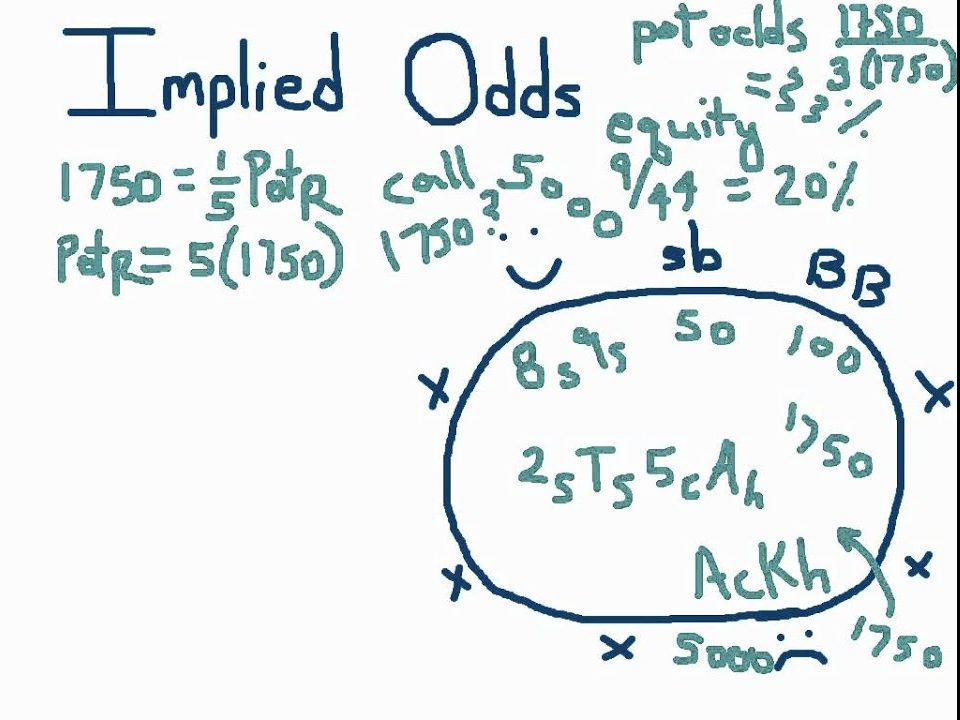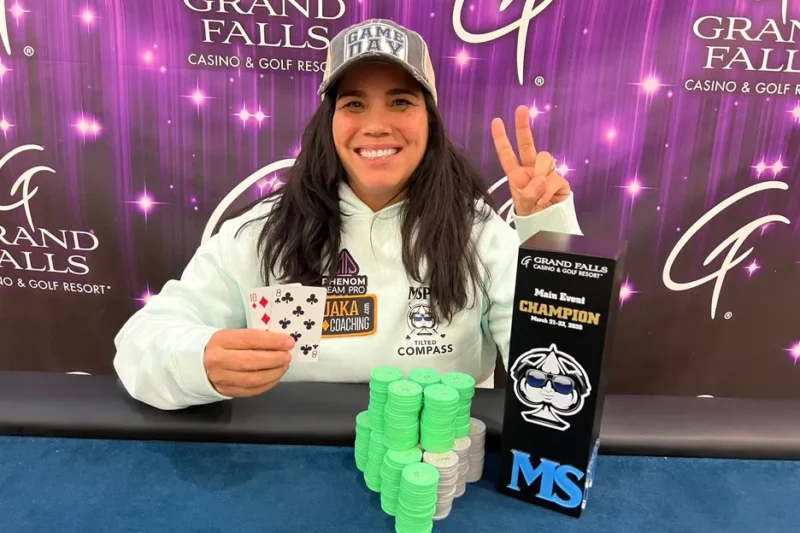One of the important concepts that successful No-Limit Hold’em players must understand and apply is the concept of implied odds. The problem is that many otherwise good players who have a basic understanding of the concept, misapply it.

Let’s review what implied odds are, how they are misapplied, and how to correctly apply them. To understand them we must first quickly review basic drawing and pot odds.
Drawing Odds and Pot Odds
Drawing odds are the odds against improving to the hand that you think is necessary to win. They are generally expressed as a ratio. For example, on the turn, drawing for a flush with two cards of your suit in your hand and two of your suit on the board is very roughly 4 to 1 against you. Drawing a full house when holding two pair is roughly 12 to 1 against you.
Pot odds are the odds that the pot is offering you at the time you are considering whether to call a bet. If your opponent bets $25 into a $50 pot, then you are getting 3 to 1 pot odds, as you stand to win a $75 pot for your $25 call.
When the pot odds that you are being offered are greater than your drawing odds, that is generally considered a good bet. Conversely, when the pot odds are less than the drawing odds, that is generally a bad bet.
Applying Drawing Odds and Pot Odds
Using this analysis, if you’re on the turn with a flush draw and are convinced you need a flush to win the hand, calling your opponent’s $25 bet into a $50 pot would be an error.
The drawing odds would be roughly 4 to 1 against you, while the pot odds would only be 3 to 1. The pot odds are less than the drawing odds, making that a bad bet.
Limitations of Applying Drawing and Pot Odds
But there’s a problem with that analysis; a problem that is especially significant in No-Limit poker. The problem is, the odds don’t take into consideration the possible money you might win on future betting rounds.
Let’s look at an example to see why that is.
You are playing $1/$3 No-Limit Hold’em with a $500 effective stack. The pot is $50 on the turn. As in the example above, you have a flush draw and are certain that you’ll win the hand if your flush card hits on the river. Your opponent bets $25. Should you call that bet?
As we explained above, conventional application of drawing and pot odds says that you should not, as you have only a roughly 4 to 1 chance of hitting your flush on the river and the pot is offering you a scant 3 to 1 pot odds. In this instance, however, you have an effective stack of $450 and you’re up against an extremely loose player who hates being bluffed.
In this case, you could likely make a bet on the river if your card hits knowing your opponent would be likely to call.
If you know that to be the case, you should surely call.
Explanation of Implied Odds
The true odds of what you could win compared to what you would lose by calling your opponent’s bet needs to reflect the amount in the pot when you call, and the amount you might win on the river if your hand hits.
Assuming you would fold to any bet on the river if you missed your hand, you’d have to figure out your true pot odds by adding in the extra amount you would win on the river if you bet and won.
Those true odds are called “implied odds,” and sometimes make a call correct, even when the immediate pot odds dictate otherwise.
In the above example, let’s say you determine that you can stack your loose opponent by enticing him to call a shove on the river if your flush card hits. In that case, his bet on the turn would be an easy call.
Applying Implied Odds
The pot is $50 when your opponent bets $25. You must call the $25 to see the river.
If the river isn’t a flush card, you will fold. If it is a flush card, you will shove, and you figure your opponent will call. So, if a flush card hits, you’ll win the $75 in the pot plus your opponent’s remaining stack of $450 for a total win of $525.
Figuring the drawing odds at roughly 4 to 1 against you, and the implied odds as 21 to 1 ($525 to $25 simplified), it’s an easy call.
Similarly, players justify calls on early rounds of betting, including pre-flop, with similar reasoning. They have 2♥ 2♠ in late position. An early position player raises to $10 and everyone folds.
At first blush, this would be an easy fold. The late-position player would only call if they were getting better than 7.5 to 1 pot odds since their chance of drawing a set of the flop is roughly 7.5 to 1 against them. But instead, they call, because they consider how much they might win from their opponent if they hit their set.
When they look at their opponent’s stack and see two hundred dollars, they think that the implied odds are 20 to 1 – an irresistible call. And so, they make a mistake and call.
Misapplying Implied Odds
Calls like this are frequently not justified because players are misapplying the concept of implied odds. And that misapplication costs good players a lot of money in the long run.
Here’s the problem: players often overestimate how much they are likely to win when they do win. They assume, incorrectly, that they will win their opponent’s entire stack when they hit their hand.
This thinking is often erroneous.
Just because your opponent has a stack of a certain size doesn’t mean that you will get all of it — or any of it — when you hit your hand and bet on the river. It may be true that an opponent with eight times his pre-flop bet has enough money to make a call worthwhile. But, you’d need to know that you’d win his stack every time you hit your set.
And, the thing is, you don’t know that.
So, while it’s a good idea to avoid set mining against a short-stacked opponent, it’s often a bad idea to call even when your opponent has a large stack.
Correctly Applying Implied Odds
Players must consider another critical factor when set mining or using implied odds in other settings to justify a call. Specifically, they must consider not just the size of an opponent’s stack, but the likelihood that their opponent will call future bets, and the actual amount of money their opponent is likely to lose.
Sure, some opponents are incredibly sticky and are nearly guaranteed to lose everything if you hit your hand. Against them, you can simply use their stack as an indication of how much more you are likely to win if you hit. But against most players, you must discount the amount you might win. And, in some cases, you must discount it to zero.
Here’s an obvious example. You’re up against a tough player whom you’ve faced many times before. He knows your playing proclivities and isn’t easily fooled. He bets what you presume to be his leading hand on the turn while you’re just drawing to a flush.
You both have large stacks and you’re in position. His bet gives you 2 to 1 pot odds, and you’d be a fool to justify a call by assuming that you’ll win his stack if you hit your flush. Typically, if a flush card hit the river he’d check. If you shove – or bet any significant amount, there’s a large chance that he’d fold and you’d win nothing more.
Correctly Discounting and Applying Implied Odds
In this case, you need to discount the amount you expect to win by considering both the amount you think your opponent would call, and the likelihood that he will call. None of this can be done precisely, of course, as it’s based on subjective assumptions.
Here’s an example of that. You have 4♣ 4♦ in the cutoff in a $1/$2 No-Limit game. There’s one call of the big blind. The hijack raises to $15 and has a $150 stack. Do you call or fold?
In this case, you can’t just look at his stack, see that it represents 10 times his bet, and figure a call makes sense because you’re getting great implied odds. Instead, you must first discount his stack by the rough likelihood that he’ll call your bets on later streets.
Let’s assume your opponent isn’t likely to stack off if you hit a set on the flop. If that’s the case, you need to discount that $150 to $75 and then do the math. The pre-flop pot of $20 and an additional $75 makes the amount you expect to win $95. That gives you implied odds of 6.3 to 1, making your 7.5 to 1 shot too expensive for your call.
A fold would be in order.
Here’s another example. On a flush draw, you face a $100 bet into a $200 pot on the turn against an excellent opponent with $500 behind. Before assuming that implied odds make a call correct, do your best to estimate how much you’re likely to extract from them on the river if you hit.
Think he’s more likely than not, but not certain, to call a bet of up to $100 if you hit your flush? Roughly, that’s about a 75% certainty of winning $100. If that’s the case, you’re looking at winning $375 total for a $100 call.
It would be a closer call than if you didn’t think about the last betting round. But 3.75 to 1 is still shy of the slightly greater than 4 to 1 pot odds you’d need to justify a call. Fold to his bet.
Conclusion
Implied odds are a critical consideration in No-Limit Hold’em. Recognizing them in your calculations can sometimes turn what would have been an obvious fold into an obvious call. But misapplied, implied odds can seduce us into making calls we want to make, but shouldn’t.
Save yourself from making expensive implied-odds mistakes by first discounting the total amount you might win by a rough estimate of the likelihood that you will win that amount. Doing so will help you make a more accurate assessment of your true implied odds.


